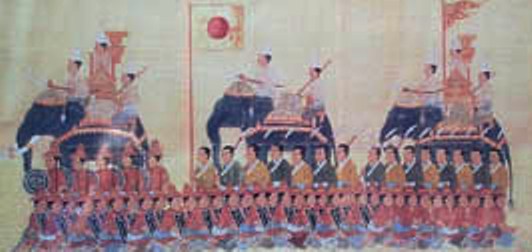The old Thai capital of Ayutthaya was a fantastically cosmopolitan place in the seventeenth century. Among others, there were French, Dutch, Portuguese, Spanish, Japanese, and Persian colonies living around the city. The Japanese residents alone included ronin, traders, and Japanese Christian refugees. (The photo above is of Japanese mercenaries in the service of the Thai king — note the elephants and the rising sun flag.)
As you might imagine, the characters that wound up in seventeenth-century Ayutthaya were not exactly run of the mill personalities. There was then apparently a job title of “adventurer,” along the lines of the Man Who Would be King: see, for example, Filipe de Brito de Nicote, the Portuguese adventurer in the nearby Arakan coast of Burma, or the unappealing Bastian Gonsalves, aka Sebastian Gonzales Tibao or Sebastian Gonslaves Tibeau. The chaotic history of the failed Portuguese colonization of Chittagong and Sandwip Island (modern Bangladesh) and Arakan is still waiting for a movie.
One of these adventurers was the Greek Constantine Phaulkon who became, briefly, an important character in late 17th century Ayutthaya and married Maria Pina de Guimar, a Luso-Japanese (presumably Catholic) mestizo.
Could you get a more obscure ethnic designation than “Luso-Japanese mestizo”? Only in Ayutthaya.
Or Macao; but that’s another story.

